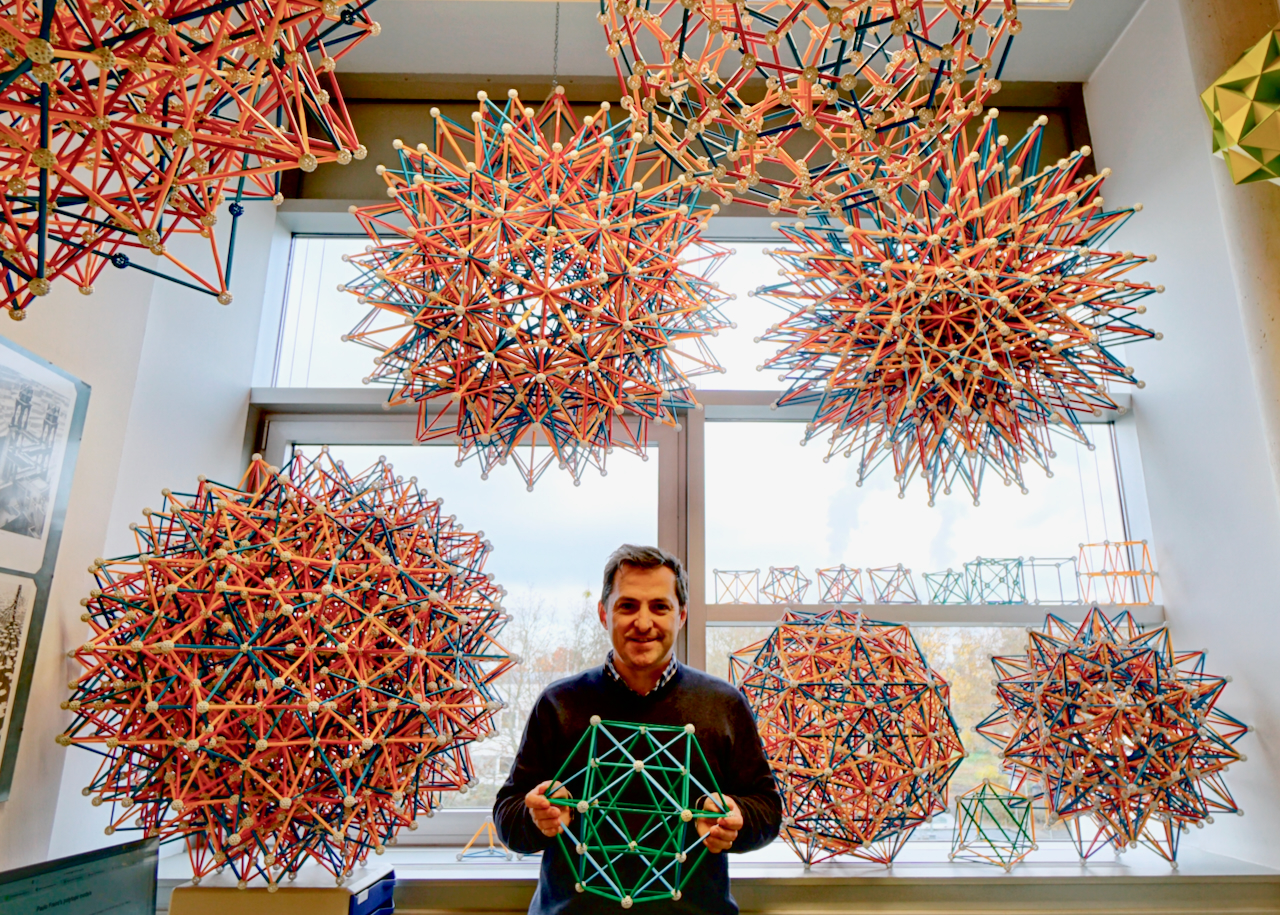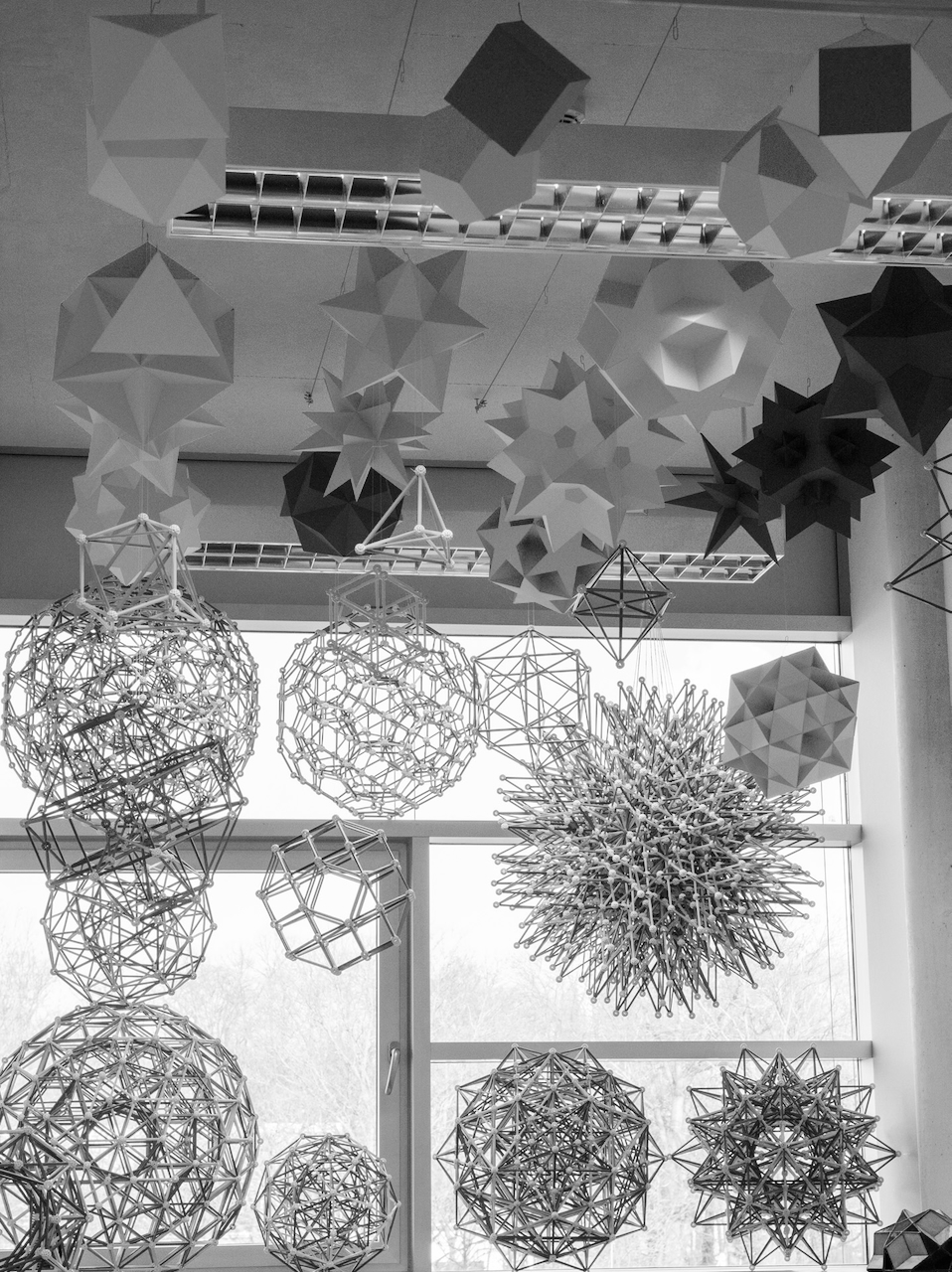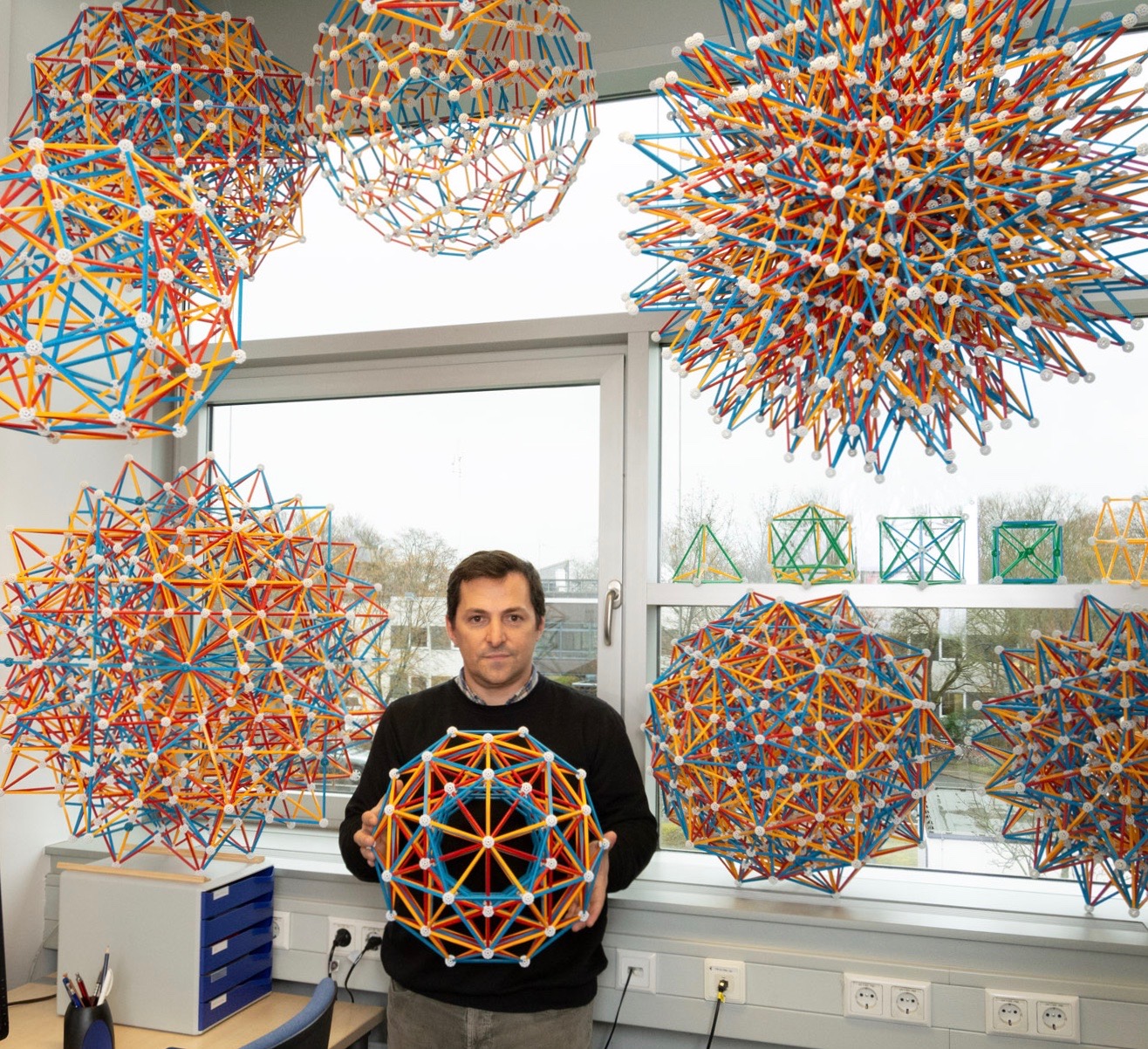First, let's have a look around!

Fig. 1.1: This is me in my polytope garden, holding a model of an orthographic projection
of the 24-cell to 3-dimensional space. Picture taken in 2022 by Alexander Kappes.
Why polytopes?
A few decades ago, I started noticing polyhedra, partly because of Carl Sagan's Cosmos, but also because of the art of M. C. Escher. After making a few simple white paper models of the Platonic solids, I was struck, as Bertrand Russell put it, by" ... a beauty cold and austere, like that of sculpture, without appeal to any part of our weaker nature, without the gorgeous trappings of painting or music, yet sublimely pure, and capable of a stern perfection such as only the greatest art can show."
Mathematical objects have this beauty because they are finished - they can only be the way they are and cannot logically be anyway else; nothing is missing, and nothing can be taken away. Being logically necessary, they were not invented, they were discovered.
Among mathematical ideas, regular polytopes - the generalization of the concept of a regular polyhedron to any number of dimensions - are easy to understand and amongst the easiest to visualise. This makes them a gateway to that world of sublimely pure beauty beyond our own.
Because of this, I continued making polyhedron models. In the late 1990's - early 2000's I built 60 models of uniform polyhedra. When I moved to Bonn, in 2009, I started making a few paper models of polyhedra for my office. In late 2013, I started playing with the Zometool, making some models of stellations and facetings of polyhedra (a particularly large sub-class of these is the stellations of the Rhombic triacontahedron).
Since 2014 I have been using the Zometool to build models of shadows (technically, orthographic projections to 3-D space) of 4-dimensional (4D) polytopes, the polychora. The reason for this is that something wonderful happens in 4D space: while higher dimensional spaces have only three regular polytopes each and no regular star polytopes, in 4D there are 16 regular polychora, with 10 of them being star polytopes! Interestingly, the most symmetric projections of all of them can be built with the Zometool! And that's exactly what I did: I built models of all regular convex and star polychora!
In addition, 4-dimensional space admits a total of 36 fully regular polychoron compounds! With the Zometool, we can build projections of 9 of them, and of course I built them all. These objects are especially interesting because, apart from being stellations and/or facetings of the regular convex polychora, their projections are, like those of the regular polychora, beautiful, complex, and challenging to build, and because of that a lot of fun. Furthermore, they nicely illustrate some important relations between different types of geometric symmetry and thus relations between the associated symmetry groups.

Fig. 1.2: A narrower view towards some of the most complex models of 4-dimensional
polytopes, taken in 2018. Photo by Aris Noutsos.
With time, my collection has been focusing more and more on the regular forms; the main reason is their unique beauty, which you can recognise immediately when you see the models. Of course, they are also mathematically more interesting. Finally, limitations of space and my inventory of the Zometool parts constrain the number of models: thus almost all models of Archimedan polychora (some of which appear in Fig. 1.2) have been replaced by models of regular compounds (Fig. 1.1). Despite these, the permanent collection in my office is now complete in the sense that it includes:
- Paper models of all regular polyhedra (plus the Platonic dice in Fig. 3.2),
- Paper models of all regular compounds,
- All Zomable projections of all regular polychora (with the exception of two boring projections of the Tesseract that appear in the projections of the 24-cell anyway),
- All Zomable projections of all Zomable regular polychoron compounds.
- Paper models of all quasi-regular and partially regular polyhedra and their duals (plus stained glass models of two quasi-regular polyhedra in Fig. 3.6b),
- One Zomable projection of the Rectified 5-cell and another one of the Snub 24-cell, which are two of the three convex semi-regular polychora,
- New: the projections of higher-dimensional regular and uniform polytopes in page 10.
Beyond this:
The objective of this site is a presentation of my polytope models, providing simple descriptions and a basic geometric understanding of the polytopes, their symmetries and their geometric relations. I generally try to explain the observed geometric properties, but some facts are presented as given - detailed explanations would require a more rigorous mathematical treatment; such as those found in the references. The metric properties of the polygons and polyhedra are covered briefly, and only to the extent thet they help us to understand the properties of some of the the 4-dimensional polytopes. Things like Euler's polyhedral formula and Descartes' theorem for angular deficiencies are not discussed in detail, as they don't apply to the non-convex polyhedra we discuss, or apply only with complex modifications, the same happens for higher-dimensional polytopes. I don't use Schläfli and Wythoff symbols, because these are partially redundant with the more informative Coxeter-Dynkin graphs, which I use to describe symmetries and polytopes derived from them using the Wythoff construction.
One important aspect is that many of these geometric properties and relations have only became clear to me while contemplating the models themselves! This highlights their usefulness as learning aids. Therefore, this site is also an evolving notebook of what I have been learning from these models. In particular, the Zometool is a great tool for displaying geometric relations. One of the features that makes it especially useful is that, in orthographic projections of uniform polychora, it highlights clearly which elements are being projected without distortion - these always appear in the same color (blue or green, depending on the model). This is great for the study of the regular and equatorial edge sections of the regular polytopes with Triangular faces, which has been most illuminating.
I hope these models will inspire some of you to start your own journey into the world of polytopes and mathematics. Follow the references! If you have any comments or suggestions for improvements, please let me know. Special thanks go to Scott Vorthmann, Nan Ma and David Richter.

Fig. 1.3:
In this picture, taken in 2019 by Aris Noutsos, I am holding a model of the 600-cell.
News:
- 2025 May: Added page on the Wythoff construction and the Coxeter-Dynkin diagrams.
- 2025 March - April: added information on the symmetries; made most of higher-dimensional models in page on higher-dimensional polytopes (in addition to Gosset's 8-dimensional figure), completely re-wrote that page.
- 2024 August - September: Introduced polygon page, numbered pages, re-made figure numbers in accordance, greatly expanded page on Archimedean polytopes.
- 2023 November: Introduced page on Archimedan polytopes.
- 2021 August - present: re-writing the whole site, learning from the models.
- 2021 July: Completed the set of paper models of the regular compounds of regular polyhedra.
- 2020 December 13: Completed the compound of 120 5-cells. As far as I know this is the first physical model of this compound. This completes my permanent collection of models built with the Zometool.
- 2020 May 10: Using vZome, Scott Vorthmann finds that the compound of 120 5-cells can be built with the Zometool.
- 2020 April 28: Completed frame of the Compound of 75 16-cells. On May 10, I finished the blue 3-intersections.
- 2019 January 26: Built model of Gosset's 8-dimensional figure.
- 2018 December 19: Completed the Compound of 15 16-cells.
- 2018 August 4: Completed the Compound of 5 24-cells.
- 2017 November 11: Completed the Great grand stellated 120-cell. This completes the list of models of all 16 regular polychora.
- 2017 November 2: Some of my models are being displayed at the Gutenberg store in Bad Godesberg. See poster here by Ⓒ the Zometool Europa / Lyn Taylor, with photos by Aris Noutsos and Jason Wu.
- 2016 November 12: Completed larger scale version of the rectified 120-cell. Later disassembled.
- 2016 February 13: Completed rectified 600-cell. Later disassembled.
- 2015: Moved to new office.
- 2014 August 21: Completed model of the Grand 600-cell.
- 2014 August 6: Completed model of the stellated 120-cell.
Next: Polygons